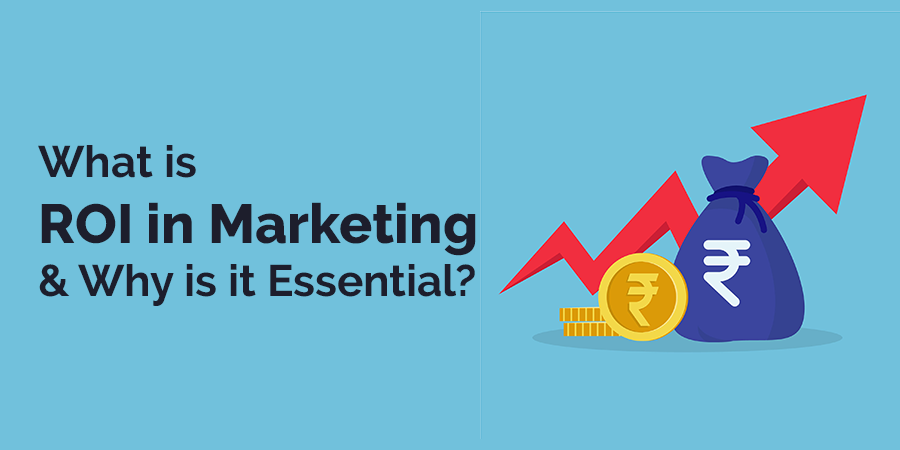If you are in the process of launching a new market campaign, the first thing you need to prioritize is to check whether it will benefit your company or not. To measure how much revenue a particular campaign will generate, marketers check its ROI. ROI stands for Return On Investment, a common concept in the business world that focuses on getting the most value out of each business expense.
Return on investment has very particular importance in the marketing field. One of the main goals is to spread money to make money and attract paying customers with persuasive advertising techniques.
In the business world, ROI in marketing helps determine how much money you will spend on a marketing project versus the amount of revenue you gain from it. Understanding the return on investment (ROI) in marketing is an important part of figuring out if a project is financially viable and coming up with a successful marketing plan.
A return on investment (ROI) is one of the crucial calculations in marketing. We will focus on knowing every detail of it and helping you to know what the actual ROI is in marketing. and why it is essential for every business. So, let’s take a close look at it.
What is ROI in Digital Marketing?
In business, ROI is one of the most crucial indicators of success, which goes with marketing. Return on investment in marketing is one of the essential financial indicators for revealing whether marketing activities are successful or not. When revenue can be attributed to marketing activities, marketers can rest assured that their work is paying off.
Measuring ROI provides insights into the effectiveness of your marketing as it defines the success rate of each campaign and empowers you with data to steer your marketing campaigns in a forward direction. Knowing your marketing ROI also places accountability on you to drive the company towards growth. Knowing your marketing numbers will also help you make critical marketing decisions like determining how much marketing budget to allocate to each strategy.

Tracking your rate of investment shows you which of your strategies are working. This information can also inform your marketing budget allocation so you can re-invest in the tactics that are bringing you to return and highlight the weak strategies.
How to Calculate ROI in Digital Marketing?
After knowing the rate of Investment in marketing, now it is time for you to understand how to calculate ROI in digital marketing. The most straightforward way to calculate ROI in marketing is the ROI in marketing formula, i.e.
ROI (percent) = [(Revenue – Investment) / Investment] x 100; it is the easiest way to calculate the return on Investment.
For many marketers, it is pretty challenging to know what qualifies as an investment.
So, if sales grew by $1,500 and the marketing campaign cost $500, then the simple ROI is 200%.
(($1500-$500) / $500) = 200%.
It’s a simple formula, but almost too simple.
Use the following formula to calculate your marketing ROI more accurately:
[(Number of leads x Lead to customer rate x Average sale price) – Cost for marketing] / Cost for marketing ]
It’s a lot to process and understand, I guess. Let’s analyse each component of this equation separately:
-
Number of Leads
The number of leads stands for the number of people who converted into a lead. These people have an established interest in your business.
-
Lead to Customer Rate
The number of people who converted from leads to customers is known as the lead-to-customer rate. Your lead-to-customer conversion rate is 30 percent, or 0.3, if 30 out of 100 leads you receive result in customers.
-
Average Sale Price
The average cost of your product is also your average sale price. When you figure out the average, you can take into account discounts and prices.
-
Cost for Marketing
The marketing cost includes the total amount you spend on your marketing campaign. This includes the money you spend on ads, the salaries of the people working on your campaign, and the software they use.
Assume you have 1000 leads, and 40% of them become clients.
They invest $200 on average.
You spent $5000 on marketing to these leads.
Inputting that into the formula results in the following:
[(1000 x .40 x 200) – 5000] / 5000
[80,000 – 5000] / 5000
75,000 / 5000
15
Once you’ve calculated your total, multiply it by 100 to calculate your ROI percentage. The ROI in this scenario is 1500 %.
What are the Best Practices for Measuring Marketing ROI
When it comes to marketing, determining the return on investment can be tricky. While social media ads and PPC (Pay-Per-Click) can provide you with more specific rates of return, it can still be challenging to link complex revenue numbers to marketing content like blogs and videos.
Nevertheless, which marketing strategy you are using, the following factors will help you determine if your marketing campaigns are successful.
1. Time
It includes the amount of time, how much time did it take to build the marketing materials.
2. Production Cost
You need to track the total cost of services, supplies, and software required to create the campaign.
3. Promotional Cost
This section includes the money you have to spend on promotion. Check if you have to pay anything for advertising; add that to your total cost.
4. Page Analytics
Use a tracking URL to determine if your published content drives traffic to your product’s landing page.
5. Non-Financial Returns
Check if you gain any social media engagement, unexpected traffic boost, or other bonuses from your campaign. If so, then this will help your level of brand awareness.
What is Good Marketing ROI?
The ideal ROI for sales and marketing is 5:1, while a ratio of 10:1 is impressive. Because the cost of manufacturing and delivering goods and services frequently causes businesses to break even with their expenses and returns, anything below a 2:1 proportion is regarded as unprofitable.
Every organisation is unique, though, therefore some may achieve success at lower ratios provided their costs and overhead are less than 50% of their sales price. It is critical to take into account the specific overhead expenses, industry considerations, margins, and standards that are specific to the industry.
What is the Importance of ROI in Marketing?
ROI is a marketing term worth learning and adding to your never-ending list. Furthermore, the marketing investment return helps you defend your marketing efforts and impress all the proper individuals. Here are some of the best that explain why ROI is vital in marketing and why all marketers should use it.
1. Aids Data-Driven Decision Making
Marketers have been making data-driven decisions in marketing for a while now, and we all know how important it is to use historical data to back up the actions and shape strategies. But blending ROI metrics into the mix takes data-driven teams to the next level. Calculating ROI proves worthwhile for your business that feels judged or undervalued by others internally.
2. Streamlines Marketing Strategy
Your marketing strategy will streamline like a piece of cake, as it is easy to drive your system into slices and chuck out those that have gone stale. You don’t need to bother with funding for the same failing PPC campaign or need to spend hours writing a new blog post. Because knowing your ROI will make a strategic decision much easier for you.
There are some intangible benefits worth keeping in your brain, especially regarding content. But not anymore, because having a high rate of investment agendas will speed up the decision-making and help you be as cutthroat as producing profitable campaigns requires.
3. Balances Marketing Budget
Measuring ROI clarifies how much you should reinvest in your next creative campaign. And when you have the right results at your fingertips, balancing your marketing budget becomes easier for you as you can quickly figure out how much you need to spend.
4. Makes Omnichannel Less Overwhelming
Attributing marketing value enables you to segment the success of your marketing campaign. Because marketing trends are rapidly changing and becoming more complex than ever, this breakdown aids in making omnichannel marketing less perplexing.
ROI extends to your understanding of the buyer’s journey and helps you with your decisions. ROI, alongside other data streams, paints an image of where most customers come from and which actions are most likely to amount to something other than brand awareness.
5. Competitor Analysis
Understanding ROI helps you ease out of your emotions and helps you look at the matter objectively. Is the competitor’s strategy similar to yours? If it is, then what is the reason? Are you doing something that you should not do? If so, then how much do you have to pay?
Performing competitive analysis is a skill that every marketer should learn and improve. But most marketers tend to approach this part of the workload lightheartedly by taking a stab at it rather than coming at it formally, just as having the ability to write competitor analysis is a job that every marketer can do. Still, only a few can do it well, and in the case of competitor analysis, having a real grasp on ROI is vital.
In a Nutshell
Marketing ROI is a vital metric to keep track of not only the benefits of the marketing team but the success of the business. It is because ROI in marketing enables your business to understand what is working well and what is worth continuing to invest in. With the above information, you know the best practices for measuring marketing ROI and how to calculate the ROI of your business.
Still, if this information didn’t help you and you want to discuss more, you can reach Nascenture at anytime as our marketing experts would love to help you. We are a leading software development company that has a team of certified digital experts who provide you with the best digital marketing services to elevate your brand and get the desired results.





